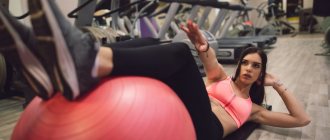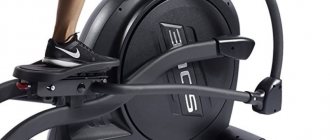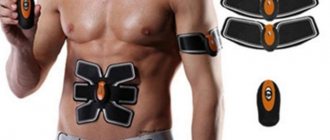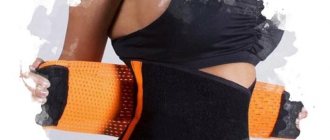The benefits of exercising with fitball
A fitball is a large inflatable ball designed to perform a wide range of exercises. Its creator is Susan Kleinvogelbach, an experienced physiotherapist from Switzerland. In the mid-20th century, she developed physical exercises with a special ball for people with movement problems.
With the help of this sports equipment it was possible to strengthen the back muscles and recover from injuries. Since the end of the 20th century, the scope of use of fitballs has expanded significantly. They began to be used in various sports sections. Today they are successfully used in maternity hospitals to ease contractions, rock babies and massage infants.
The fitball is suitable as a seat in the workplace. Sitting on it, you have to control your position so as not to roll off it. This develops the habit of maintaining posture with minimal stress on the spinal area.
Exercises on a fitball for weight loss are a great way to tighten your muscular system and achieve the desired slimness.
In addition, activities with this sports equipment:
- Improves posture.
- Helps strengthen the body.
- Increases endurance.
- Improves the functioning of the cardiovascular and respiratory systems.
- Develop excellent coordination of movements.
- Warm up joints and increase flexibility.
- Recover after childbirth, injuries and complex operations.
Fitball exercises are also recommended for pregnant women. The fact is that exercises with such equipment not only help to maintain good shape, but also prepare the muscles for childbirth and do not harm the developing fetus.
Fitball workouts for pregnant women:
- Relieves tension from the lower back.
- They put the circulatory system in order.
- Relaxes the muscles in the spine.
In addition, we can say that exercise on a fitball makes regular workouts more varied, improves your mood and fills you with energy for the whole day.
Push-ups on the ball[edit | edit code]
What muscles work?
This exercise helps add variety to your regular push-ups. It strengthens the chest, shoulders, triceps and abdomen, and also tightens the buttocks.
If you have problems with your lower back, neck, elbows or wrists, it might be best to avoid it.
Preparing for the approach.
The starting position here at first will be the same as for the ball support described above. Kneel down behind the ball and lie on your stomach. Roll slightly forward and straighten your legs back (the ball should support your lower torso). Stretch your neck back so that your ears are just above shoulder level.
Pull your stomach in, tighten your buttocks and push forward on your hands. y Stop at the point where you feel that you can still maintain your balance, but your muscles are already struggling. Place your palms on the floor directly below your shoulders. Moreover, the further your shoulders are from the ball, the more difficult it will be to perform the exercise (photo A in Fig. 4).
Exercise.
Slowly bend your elbows and lower your body down. Hold this for a few seconds, and then straighten your arms and push up from the floor (photo B in Fig. 4).
How to choose a suitable fitball: criteria and rules
When choosing a fitball, it is recommended to pay attention to the following points:
- The maximum permissible weight that the ball can support. This criterion is primarily important for overweight people and those who will use dumbbells during training.
- The equipment should have the abbreviation “ABS” on it, indicating the presence of an anti-burst system. Thanks to it, the fitball will not tear or burst during training.
- When choosing a ball, you need to sit on it with your back straight and your feet together in front of you. If your knees form a 90º angle, the ball is fit for use. If the angle is smaller or larger, you must first check whether the sports equipment is overinflated or deflated. If necessary, you should pump up the ball or deflate it a little, and then sit on it again. It will be uncomfortable to sit on a fitball with the wrong diameter, as the pressure on the joints and spine increases.
You can also choose the correct fitball diameter based on a person’s height.
Ratio of human height to ball diameter:
| Height, m | Recommended diameter, m |
| Below 1.51 | 0,45 |
| 1,52 – 1,64 | 0,55 |
| 1,65 – 1,79 | 0,65 |
| 1,80 – 2,00 | 0,75 |
| From 2.00 | 0,85 |
When choosing a suitable ball, it is also recommended to look for the presence of a pump. However, if it is not there, then you can always pump up the fitball with a regular bicycle pump.
Support on the ball[edit | edit code]
What muscles work?
This exercise has a fantastic effect on strengthening the supporting muscles of the body. It helps develop stabilizers in the shoulders, abdomen and back, as well as the buttocks.
Make sure that as you exhale, the bottom of your pelvis is raised and your stomach is pulled in.
Preparing for the approach.
Kneel down behind the ball and lie on your stomach. Roll forward slightly and straighten your legs back (the ball should support your lower torso). Stretch your neck back so that your ears are just above shoulder level (Photo A in Fig. 3).
Exercise.
Pull your stomach in, tighten your buttocks, and begin to raise your arms forward and up. Stop when your hands are just below shoulder level. You should feel your muscles working but be able to maintain a straight posture. The higher your shoulders rise above the ball, the more difficult the exercise will be. Keep your shoulders down and your neck long. Do your best to keep your head up. Hold with your arms raised for 30 seconds, then lower them back down and repeat. Alternatively, you can hold for just a couple of seconds, but do three to five quick repetitions in a row.
Class rules, precautions
Exercises using a fitball have a number of rules and caveats:
- It is recommended to choose a spacious room for ball training. All sharp and large objects should be removed from the ball, as such proximity can lead to an unpleasant situation and even injury.
- Each workout should begin with a full-body warm-up, which will take no more than 10 minutes.
- If you can’t keep your balance, it is recommended to place small pillows at the base of the ball before starting exercise. Thanks to this, the fitball will become more stable.
- Concentration is a necessary condition for the successful and correct execution of each physical exercise. During exercise, you need to constantly maintain balance, which involves a large number of muscles.
- When training, you need to monitor your breathing. It should be smooth and rhythmic. While maintaining balance, you should never hold your breath.
- You should sit on the ball with a straight back so as not to overstrain the spinal muscles.
- If pain or discomfort occurs during exercise, you should stop and choose easier and more suitable workout options.
Choosing the right ball[edit | edit code]
choosing a fitball
To effectively practice fitball, you first need to find a quality ball, the size of which will be suitable for your body. From her experience as a personal trainer, Shirley knows that the most common mistake people make is sizing. As a rule, athletes think that everything is simple; the more, the better, and cheaper means more profitable. Meanwhile, if you want your training to really bring results, you need to pay close attention to the size and quality of the ball.
choosing a fitball
When you sit on the ball, your hips should be at the correct angle to the floor. For people with a height below 140 cm, the diameter of the ball should be 45 cm. For a height from 140 to 160 cm, it should not be more than 55 cm. For a height of 160 to 180 cm, the recommended ball diameter is 65 cm. Finally, for people taller above 180 cm, the size of the ball should be 75 cm. The softer the product, the easier it is usually to balance on it. Thus, if you are just starting to exercise, you can buy a ball with a slightly larger diameter than necessary and not fully inflate it, so that it is softer and more comfortable. Then you can make the task more difficult for yourself by fully inflating the ball so that it rolls easily and it is not at all difficult to maintain balance on it. Try to only use balls specifically designed for fitness.
When going to the store to buy a fitness ball, pay attention to the following characteristics.
- Weight check.
Modern manufacturers create balls that can withstand loads of up to 450 kg. Although you may not need such a ball, always try to research the features of your future purchase. Make sure that your training ball has been specially tested and can withstand at least 250 kg of weight, or even more.
- Tear resistance.
Nowadays, fitness balls are made of dense materials that are more resistant to punctures. Since you can get quite seriously injured when falling to the ground from a burst ball, try to find a stronger product for yourself. Additionally, the more puncture-resistant your ball is, the longer it will last when used on uneven surfaces.
- Deflation speed.
A ball that deflates slowly when punctured significantly reduces the risk of injury. The deflation speed is very important because if the ball deflates instantly, you can easily fall off it onto the floor and get hurt. This is especially important to remember when you are training on a ball with dumbbells, which increases your body weight and stress on your arms. After all, when your hands are full of dumbbells, you cannot grab onto something and slow down your fall. Of course, a special ball with slow deflation may cost more than a regular ball, but you clearly don’t need to waste money on it.
Contraindications to training
People of almost any age and health status can train with a fitball. However, there are still a small number of contraindications for such sports equipment.
Exercises on a fitball for weight loss are contraindicated if:
- Pathological process of internal organs.
- Intervertebral hernia.
- Severe diseases of the cardiovascular system.
- Pregnancy up to 12 weeks.
If you are pregnant or have any illness, you should definitely consult your doctor before starting training with a fitball.
Alternate rise, feet on the ball[edit | edit code]
What muscles work?
This exercise greatly strengthens the buttocks, as it actively engages their muscles. Just remember to keep your stomach tucked in to support your lower back.
Preparing for the approach.
Kneel down behind the ball and lie on your stomach. Roll forward slightly and straighten your legs back (the ball should support your lower torso). Stretch your neck back so that your ears are just above shoulder level. Place your hands on the floor directly below your shoulders, lower your shoulders, and squeeze your glutes (Photo A in Figure 5).
Exercise.
Alternately raise your right and left legs to the height of your buttocks, hold for a couple of seconds, and then lower them to the floor, returning to the starting position (photo B in Fig. 5). As you get stronger over time, go further and start lifting both legs at the same time (Photo B in Fig. 5).
Exercises for losing weight on the abdomen and sides
Regular exercises using a special ball in a sitting or lying position help strengthen the abdominal muscles. They get rid of excess belly fat, tightening it and making it attractive.
They also help to work the deep and oblique abdominal muscles, which are rarely used during classical training. It is worth noting that exercises on a special ball are not dangerous, since the fitball relieves the load on the lumbar region.
Crunches
This exercise will help pump up your rectus abdominis muscles.
It must be done in the following sequence:
- Sit comfortably on the fitball. Bring your legs together and place them in front of you.
- Cross your arms over your chest or place them behind your head (do not clasp your fingers).
- Take a breath. As you exhale, tense your abs, slowly tilting your head forward, then your shoulders and body. Press your chin lightly towards your chest.
- While inhaling, return to the original position.
The lower you tilt your body forward, the more effective the stretching of the abdominal muscles will be.
Hyperextension
This exercise helps pump up your abs and develops your back muscles.
It should be performed in the following sequence:
- Lie down on the fitball so that your stomach and pelvis are completely placed on the ball.
- Place your hands behind your head without interlocking your fingers.
- The body should form a straight line.
- As you inhale, bend back to the most comfortable level.
- When exhaling, return to the original position.
When performing the exercise, you cannot help yourself with your hands, and also keep your abdominal muscles tense for a long time.
Transferring a fitball from hands to feet
Due to its complexity, this exercise is recommended only for those people who have good physical fitness.
Sequencing:
- Lie on your back on a mat or small rug. Legs should be straight.
- Raise the fitball above your head without bending your elbows.
- Tighten your abdominal muscles and slowly sit down.
- Turn to the left and then to the right.
- Lower the fitball and hold it between your knees.
- Without bending your legs, return to the mat in a lying position.
- Tighten your abdominal muscles and slowly rise to a sitting position.
- Take the ball and turn your body with it to the left and right.
- Return to original position.
The training should be carried out without jerking, smoothly and leisurely.
Safety when using fitness balls[edit | edit code]
Other than occasional cleaning, deflation and inflation, the balls require very little maintenance. The tips below will help you use them as effectively as possible for many years.
- Storage.
Your main task when practicing with a ball is to determine how to store it correctly. If you don't have enough free space, deflate the ball between uses and then inflate it again. By the way, it will be very convenient to purchase an electric pump for this, which will save you a lot of time and make your work much easier.
Some fitness balls have special extensions, reminiscent of a cow's udder, that prevent them from rolling away and allow you to store them in the corner of the family room. Others are sold with convenient round plastic stands. However, any balls should not be stored near a heat source as this may cause them to expand, stretch or soften.
- Cleaning.
To clean the balls, use a soft cloth or sponge and clean warm water or a mild soap solution if necessary. Chemical cleaners can easily damage the surface of the ball. In general, try to use your ball only on a clean, dry floor. This precaution will help keep the ball clean and even prevent it from being punctured.
- Pumps.
Many large balls today are sold complete with a pump - usually hand or foot. If you only have one large ball and rarely pump it, a hand pump will be sufficient. However, if you deflate and inflate the ball often, say, for transportation, we advise you to buy a more convenient and faster electric pump.
- Free place.
When purchasing a fitness ball, remember to make sure that where you usually exercise has enough space to work with it. This area should be wider and longer than your height. Make sure there is no furniture with sharp protruding edges. Remember that while balancing on the ball, it is difficult to maintain balance, and therefore you will not be able to clearly control your every movement. Therefore, the exercise area should always be free and clean.
Try to make ball work a regular part of your weekly strength training plan. This will give them the variety they need, allowing them to work the muscles in different ways, and will also help make the exercises more interesting and fun. As with any strength exercise, unless otherwise stated, perform 8 to 15 reps per set and at least one set per muscle group. Once you begin to easily perform all 15 repetitions, make the task more difficult in two main ways. Firstly, you can reduce the support (raising one leg or bringing your legs closer to one another), and secondly, additionally use weights like dumbbells.
To burn fat on the buttocks
Fitball relatively quickly gets rid of excess fat on the buttocks. With regular exercise, cellulite is reduced and muscles become firmer.
Bridge
The exercise successfully helps burn fat and strengthen the lower back, relieving it of pain and tension.
Subsequence:
- Lay out the mat and lie on it with your back.
- Raise your legs, placing your feet completely on the ball. Your knees should form a right angle.
- As you inhale, lift your buttocks up without lifting your shoulders from the mat.
- When exhaling, return to the original position.
Leg pull-up
The exercise tightens the buttocks and thighs and effectively combats “orange peel” skin. Even beginners can do it.
Sequences:
- Lay out the mat and lie on it with your back.
- Place your legs straight on the ball.
- Pull your knees as close to your chest as possible. At the same time, you should roll the fitball towards you with your feet.
- Straighten your legs, rolling the ball back and returning to its original position.
Reverse squat
The exercise works well not only the buttock area, but also the inner thigh. It also trains balance and improves stretching.
Subsequence:
- Turn your back to the fitball lying on the floor.
- Take your left leg back. Place the straightened toe on the ball.
- Bend your right leg while keeping your left limb on the ball.
- Straightening your right leg, carry out the same procedure, but with your left leg.
March on the ball[edit | edit code]
What muscles work?
This exercise perfectly develops the buttocks, back of the thighs and deep supporting muscles. It's not easy to do, so be patient.
Be careful if you have lower back problems.
Preparing for the approach.
Sit on the center of the ball and place your feet hip-width apart on the floor. Place your hands behind your head so that your thumbs are behind your ears. Do not intertwine your fingers in a lock, so as not to accidentally injure yourself later.
Keep your elbows out to the sides and slightly rounded inward. Tuck your chin slightly and lengthen your neck to look down at your torso. Pull your stomach in and position yourself so that your upper back rests comfortably on the ball and your hips hang in the air, supported by your legs. Remember that the farther you place your feet from the ball, the more difficult it will be for you to perform the exercise later (photo A in Fig. 2).
Exercise.
Keeping your abdominal and buttock muscles tight and your torso parallel to the floor, alternately lift and lower your right and left feet, as if you were marching in place. Do at least ten repetitions for each leg, concentrating on not raising or lowering your torso (Photo B in Figure 2).
For slimming thighs
Fitball is an ideal remedy for cellulite and problematic thighs. During training with the ball, most of the muscles of the lower extremities are involved, thanks to which the much desired slimness of the thighs can be achieved.
Static squat
This exercise requires good coordination of movements. During this exercise, be sure to keep your back straight.
Subsequence:
- Stand with your back to the wall. Fix the ball between the vertical surface and your back.
- Take 1-2 steps forward, while holding the fitball against the wall.
- While maintaining this position, slowly squat down, allowing the fitball to roll along the vertical surface. Squat until your thighs are parallel to the floor.
- Hold this pose for 20 seconds.
- Return to starting position.
Leg raise
There are 2 types of this exercise: straight and inverted. With a direct approach, you should lie on your back, with an inverted position - on your stomach.
Subsequence:
- Lay out a mat and lie on it with your back or stomach.
- Gently lift your feet onto the ball.
- Alternately raise one or the other leg up, without bending them at the knees. In this case, the body should remain tightly pressed to the frame.
Swing to the sides
This is a fairly difficult exercise for people who do not have good physical skills. The fact is that to perform it you need strong arms and abdominal muscles. When training, you should not arch your lower back to avoid problems with it in the future.
Subsequence:
- Place your palms on the floor.
- Place straight legs on a fitball.
- Alternately move each leg to the side.
Beginners can perform an easier version of this exercise.
Sequencing:
- Place your emphasis while lying down, placing your palms on the surface of the ball. Do not bend your arms at the elbows.
- Take your right leg to the side. Hold it in the indicated position for 1-2 seconds.
- Repeat the above steps with your left leg.
Abdominal crunch on the ball[edit | edit code]
Main articles:
Exercise ball crunch, Reverse exercise ball crunch, and Side exercise ball crunch
What muscles work?
This exercise strengthens your abdominal muscles, forcing you to balance and limiting all other movements. As you get stronger, you will benefit from the benefits of training on a round, sloping ball surface rather than a flat floor.
Preparing for the approach.
Sit on the center of the ball, placing your feet on the floor as wide as necessary to maintain balance.
The closer your legs are to one another, the more difficult it will be to perform the Exercise.
Place your hands behind your head so that your thumbs are behind your ears. Do not intertwine your fingers in a lock, so as not to accidentally injure yourself later.
Keep your elbows out to the sides and slightly rounded inward. Lower your chin slightly and lengthen your neck. Pull your stomach in and lean back so that your entire back, from your shoulders to your tailbone, rests on the ball. Only the head and arms can hang over it (photo A in Fig. 1).
Exercise.
Bend your torso forward and upward to lift your shoulder blades off the ball. Move slowly and carefully to maintain good balance and limit any movement other than twisting. Pause briefly at the top of the movement, and then slowly lower back down to the starting position (Photo B in Fig. 1).
Back and arm workout
Exercises on a fitball for losing weight on your arms and back do not load your spine. They strengthen your back muscles, pump up your arms and improve your posture.
boat
The exercise not only successfully works the back muscles, but also helps strengthen the lower abdominals.
Sequences:
- Lay out the mat. Place yourself on it with your stomach down.
- Do not squeeze the ball too much between your feet.
- Straighten your arms and extend them forward.
- As you inhale, raise your arms and legs up without bending them.
- Hold this position for 1-2 seconds.
- When exhaling, take the original position.
Dumbbell bench press on fitball
Training with a fitball and strength equipment successfully works the muscles of the arms and chest.
Subsequence:
- Place your back on a fitball, bending your knees.
- Take dumbbells weighing 1-2 kg.
- Bend your elbows.
- As you inhale, bring your elbows together in front of your chest.
- As you exhale, move them apart.
Oblique abdominal crunch on a ball[edit | edit code]
What muscles work?
This exercise is aimed at developing the abdominal muscles, especially the oblique muscles that surround the waist.
Preparing for the approach.
Sit on the center of the ball, placing your feet on the floor as wide as necessary to maintain balance.
The closer your legs are to one another, the more difficult it will be to perform the Exercise.
Place your hands behind your head so that your thumbs are behind your ears. Do not intertwine your fingers in a lock, so as not to accidentally injure yourself later.
Keep your elbows out to the sides and slightly rounded inward. Lower your chin slightly and lengthen your neck. Pull your stomach in and lean back so that your entire back, from your shoulders to your tailbone, rests on the ball. Only the head and arms can hang over it (photo A in Fig. 1).
Exercise.
Bend your torso upward, rotating your right shoulder toward your left hip so that your right shoulder blade lifts off the ball. In this case, the buttocks should lie motionless on the ball. Move slowly and carefully to maintain good balance and limit any movement other than twisting. Pause briefly at the top of the movement and then slowly lower back down to the starting position. Repeat the same for the left shoulder.
Fat burning exercises
Fitball exercises for weight loss are more effective if performed in combination. During complex exercises on the ball, most of the muscles of the body are worked out. The type of training and its duration are selected depending on the physical capabilities of the person and his state of health. Before starting exercises, a warm-up is necessary to warm up the muscles.
Suitable for this purpose:
- run;
- squats;
- jumping on 1 or 2 legs;
- swing the lower and upper limbs to the sides;
- body turns.
Warm-up lasts 5-10 minutes.
Everyday complex for beginners
The weight loss exercises from this complex are designed for the initial level of physical fitness. Their duration is only 5-7 minutes. To achieve the desired result, training on a fitball should be carried out regularly.
Daily program:
| Name | Duration | Number of approaches |
| Power press | 10 times | 2 |
| boat | 5 times | 3 |
| Swing your legs to the side | 15 times for each leg | 1 |
| Leg raises while lying on your back | 15 times for each leg | 1 |
After all the exercises, it is recommended to stretch the muscles of the inner thigh for 10 minutes.
Complex for experienced
This program lasts 6 days. Once every 2 days you should increase the number of exercises by 4-5 times. The duration of the static squat should be increased to 2 minutes. On the 7th day it is recommended to take a break.
The photo shows effective exercises on a fitball for weight loss.
Daily program:
| Name | Duration | Number of approaches |
| Twisting the body to work the abdominal muscles | 20 times | 3 |
| Leg Raise | 20 times | 3 |
| Hyperextension | 15 times | 2 |
| Passing the ball from hands to feet | 15 times | 2 |
| Static squat | 60 sec | 2 |
| Bridge | 15 times | 3 |
| Reverse squat | 15 times for each leg | 1 |
Complex for women after childbirth
Pregnancy is a real test for the female body. After giving birth, a simple training program with a fitball will help you return your body to an attractive shape and get rid of excess fat. All exercises should be done in 1 approach.
Daily program:
| Name | Duration |
| Static squat | 60 sec |
| Bridge on the ball | 20 times |
| Lifting a fitball with your feet | 20 times |
| Plank with emphasis on the surface of the ball | 60 sec |
| Twisting the body | 15 times |
You can finish your workout with a 5-minute stretch on the ball.
Complex-charging
This complex is done in the morning. It perfectly trains the muscles of the body, charges you with energy and a great mood for the whole day. All exercises should be done in 1-2 approaches.
Daily program:
| Name | Duration |
| Torso twists while sitting on a ball | From 30 to 60 sec |
| Jumping while sitting on a ball | From 30 to 60 sec |
| Tilt the body to the side while sitting on the ball | 15 times in each direction |
| Plank | 60 sec |
| Jumping while holding a fitball in your hands | 60 sec |
Exercises on a fitball to strengthen body muscles and lose weight can be performed at any rhythm. The use of strength equipment, such as dumbbells, will increase the effectiveness of training.
Pros and cons of exercising on a fitball
Positive aspects of using a gymnastic ball in training:
- unstable support allows you to engage even the deepest muscles that fix parts of the skeleton relative to each other;
- the more muscles are used during training, the more calories are expended to perform this type of activity;
- the ability to exercise with varicose veins and some injuries of the lower extremities, since the load on them is minimal (while sitting on a ball);
- coordination and the vestibular apparatus develop, which allows for better orientation in space;
- gradual increase in load;
- no age restrictions: exercises can be selected for both children and the elderly;
- widely used for recovery from injuries to the spine and shoulder joints;
- an effective simulator for relaxation after a hard day;
- fitball can be used as a weighting agent;
- relieves stress from the spine, reduces pain;
- low cost of the projectile;
- Most fitball models have an “Anti-explosion” system: when damaged, the ball does not explode, but slowly deflates.
The only disadvantage of this simulator that can be highlighted is the weight limit. Depending on the manufacturer, the maximum user weight can reach either 100 kg or 170 kg. Before use, be sure to read the instructions.
There are also a number of contraindications for health reasons: for acute diseases of the respiratory and cardiovascular systems, for hernias, during the acute period of injury and during pregnancy. If any of the above applies to you, or you are unsure of your health, then you need to consult your doctor and get approval to use a fitball in your workouts.
“Bridge” on the ball[edit | edit code]
Main article:
Ball bridge
What muscles work?
This exercise develops the supporting muscles of the torso, while simultaneously strengthening the muscles of the buttocks and back of the thighs. For Shirley, this is one of Shirley's favorite ball exercises on the entire planet.
Preparing for the approach.
Lie face up on the floor and place your feet on top of the ball. Place your arms loosely at the sides of your body, palms up. This position will help you open your chest and shoulders, but will not allow you to use your arms to push up from the floor. (By the way, remembering that you cannot do push-ups, you can place your hands on the floor with your palms facing down.) Relax your shoulders and stretch your neck back (photo A in Fig. 6).
Exercise.
Tighten your glutes and biceps and push your body up into your heels. Squeeze your buttocks and hamstrings, hold for a few seconds, and then slowly lower back down to the starting position. Continue to keep your stomach pulled in throughout the exercise to provide support to your lower back (Photo B in Figure 6).
Lifting both legs with the ball while lying on your side[edit | edit code]
Main article:
Lifting the ball while lying on your side
What muscles work?
This exercise develops the inner and outer thighs along with the buttocks, and also strengthens the supporting muscles. Because when you lift the ball, you have to work to stabilize your upper body and hips.
Do not do this exercise if you have lower back problems or discomfort.
Preparing for the approach.
Lie on your side with your arm bent at the elbow directly underneath your head and place the ball between your ankles. Relax your upper body and additionally press your other hand into the floor, placing it in front of your chest (photo A in Fig. 8).
Pull your stomach in and tighten your buttock muscles to provide the necessary support to your lower back. Make sure that your lower ribs do not stick out to the sides.
Exercise.
Tighten your inner thigh muscles and squeeze the ball tightly. Raise it a few centimeters above the floor, hold it for a while, and then slowly lower it back to the starting position. After completing a set for one side of the body, change position and do the same number of repetitions for the other side (photo B in Fig. 8).











